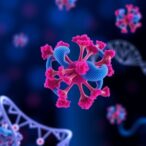Sponsored content brought to you by
Accurate genomic profiling is essential for clinical decision-making and optimizing treatment recommendations. Tumor-only sequencing has been adopted by many laboratories to guide precision oncology approaches; however, a major limitation of this approach is its inability to distinguish true somatic mutations from germline variants with certainty. It is estimated that up to one-third of mutations identified through tumor-only sequencing may be false-positive germline changes, including those in actionable genes.1
Matched tumor-normal sequencing is an effective strategy involving the paired analysis of a tumor sample and a normal sample from the same individual.1– 4 When variants present in the normal sample are used as a filter against the tumor sample, tumor-specific variants can be identified with a high degree of confidence. Variants found at low frequencies in the normal sample can be reliably classified as false positives if they are not significantly enriched in the tumor.

While the most important function of matched tumor-normal sequencing is to identify and retain somatic mutations, it also serves other important functions. These include:
- Reducing false positives due to sample variability and sequencing artifacts
Samples can exhibit variability due to factors such as environmental influences, biological processes, and sample handling. Matched tumor-normal sequencing provides a built-in baseline of background noise resulting from these factors, or from introduction of sequencing artifacts, which can be filtered out.
In the case of formalin-fixed, paraffin-embedded (FFPE) samples, extracted DNA is often fragmented and of a lower quality than fresh tissue samples. Matched tumor-normal sequencing provides a comparison that helps distinguish true alterations from noise resulting from degradation of the DNA, enhancing sensitivity.
- Reducing false positives from clonal hematopoiesis of indeterminate potential (CHIP) variants
Cell-free DNA (cfDNA) obtained from liquid biopsy samples includes DNA from tumor cells as well as a significant amount of DNA from white blood cells. In many individuals, especially those who are older, these phenotypically normal blood cells contain acquired mutations subsequently increased in relative frequency due to clonal expansion. These CHIP variants can often occur in the same genes associated with blood cancers like leukemia. However, while they are indicative of an increased risk of developing a blood cancer in the future, they are not likely to be relevant to the tumor being analyzed.
Sequencing matched white blood cells as a normal control can successfully distinguish somatic mutations that drive tumorigenesis from somatic mutations arising from the normal process of clonal hematopoiesis.4 Both ESMO and AMP recommendations specify that matched white blood cell sequencing should be used for interpretation of somatic variants in cfDNA testing.5,6
- Streamlining germline variant analysis
The ability to distinguish between somatic and germline variants has the additional benefit of streamlining analysis of germline variants that have additional implication for a patient’s clinical care, most notably in providing information about future disease risk that can be managed in part through surveillance, as well as allowing for testing of family members who may also be at risk for disease.
Interested in leveraging a matched tumor-normal approach for your clinical research? We have collaborated with Memorial Sloan Kettering Cancer Center (MSK) to decentralize their best-in-class next-generation sequencing (NGS) assays—MSK-ACCESS® for liquid biopsy and MSK-IMPACT® for comprehensive genomic profiling—via the SOPHiA DDM™ Platform. Institutions worldwide can enhance their research with an easy-to-adopt matched tumor-normal workflow, improving somatic detection rate for robust precision oncology insights.
References
- Jones, S, et al. Sci Transl Med. 2015. 7(283):283ra53.
- Mandelker, D, & Ceyhan-Birsoy, O. Trends Cancer. 2020;6(1):31-39.
- Cheng, D.T, et al. J Mol Diagn. 2015;17(3):251–264.
- Brannon, A.R, et al. Nat Commun. 2021;12:3770
- Pascual, J, et al. Ann Oncol. 2022;33(8):750-768.
- Lockwood, C.M, et al. J Mol Diagn. 2023;25(12):876-897.




